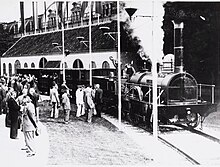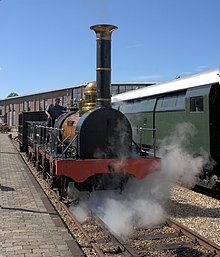Arend (locomotive)
| Arend, Leeuw | |
|---|---|
|
Replica of the Arend from 1938 in Het Spoorwegmuseum
|
|
| Numbering: | Arend and Leeuw ( De Arend ) |
| Number: | 2 (1) |
| Manufacturer: | Longridge & Co. (Centrale Werkplaats Zwolle) |
| Year of construction (s): | 1839 (1938) |
| Retirement: | 1856-1857 |
| Axis formula : | 1A1 n2 |
| Type : | Patent tea |
| Gauge : | 1945 mm |
| Length: | 9,785 mm |
| Height: | 4,600 mm |
| Service mass: | Locomotive : 12 t (19.3 t) |
| Top speed: | 30 km / h |
| Starting tractive effort: | 905 kg |
| Driving wheel diameter: | 1,810 mm (1,800 mm) |
| Impeller diameter: | 1,140 mm (1,100 mm) tender : 1,060 mm (1,060 mm) |
| Number of cylinders: | 2 |
| Cylinder diameter: | 356 mm |
| Piston stroke: | 450 mm |
| Boiler overpressure: | 4.13 kg / cm² |
| Grate area: | 1.13 m² |
| Radiant heating surface: | 5.9 m² (6.5 m²) |
| Tubular heating surface: | 42.3 m² (36 m²) |
| Water supply: | 3.3 m³ |
| Fuel supply: | 600 kg of coke |
| The information in brackets relates to differences in the construction of the replica | |
The Arend (German: Adler) was - after the previously delivered Snelheid (German: speed) - the second steam locomotive in the Netherlands . On September 20, 1839, the Arend and the Snelheid pulled the inaugural train of the Netherlands' first railway line between Amsterdam and Haarlem . The original locomotive no longer exists, but a replica from 1938 has been preserved.
history
Founded in 1837 Hollandsche IJzeren Spoorweg-Maatschappij (HSM) ordered in July 1838 at the factory RB Longridge & Co in Bedlington four locomotives from Stephenson patented type Patentee with the wheel arrangement 1A1, the names Snelheid , Arend , Hoop and Leeuw received. The Arend and the Leeuw were similar, but differed in some respects from the Snelheid and the Hoop . In May 1839 the Snelheid was the first to be delivered, followed by the first test runs of the locomotive. With the delivery of the Arend at the beginning of September 1839, train traffic could begin. The opening trips took place on September 20 and 21, 1839, and regular traffic began on September 24, 1839. The Leeuw was delivered on December 26, 1839 as the fourth locomotive.
The Arend and the Leeuw did service on the HSM's broad-gauge line, which was extended to Leiden in 1842 and to The Hague in 1843 and finally reached Rotterdam in 1847 .
By 1848 the hoop was in poor condition . It was suggested to use this locomotive as a spare part dispenser for the Snelheid . Such a plan was also prepared for the Arend and the Leeuw . Because of the bad experience with the Leiden locomotive and the cancellation of the order for two identical locomotives, there would have been no replacement locomotives for the locomotives to be withdrawn. Therefore it was decided to completely overhaul the oldest four locomotives. After the Snelheid and the Hoop were overhauled in 1848 and 1849, the Leeuw and Arend were overhauled in 1850 and 1851, respectively.
After the Nederlandsche Rhijnspoorweg-Maatschappij (NRS) had rebuilt their lines from broad gauge to standard gauge in 1854–1855 , the HSM tried to take over some of the newer NRS broad gauge locomotives that were no longer required to replace the oldest of their own locomotives. The NRS had already sold all of these to the merchant BJ Nijkerk in Amsterdam. HSM agreed with this dealer to swap twelve locomotives at an additional price of 2000 guilders per locomotive. In 1856 the Leeuw was exchanged for the newer, former NRS locomotive 16 Bromo . The Bromo was immediately rejected and returned to the contractual partner. In 1857 the Arend was exchanged for the NRS 12 Vesusius , which was in service with the HSM until 1863. All of these locomotives were then scrapped.
Replica
In 1938 the Centrale Werkplaats in Zwolle built a replica in honor of the centenary of the Dutch railways. The original drawings of the sister locomotive Leeuw were available, based on which a replica of the Arend , which was delivered to HSM as the second locomotive , was built. Together with three cars the locomotive when shooting for the film was 100 jaar spoorwegen in Nederland ( German 100 years of railways in the Netherlands ) in the station Hoofddorp used.
In the summer of 1939, the Arend was used to make tours of the exhibition grounds, which had been set up for the centenary of the railway on Frederiksplein in Amsterdam . A trip with two laps cost ten Dutch cents. At least 100,000 people have made use of this option. The train covered more than 3000 kilometers on the site. Then the locomotive was parked in the workshop shed in Zwolle. There the locomotive survived the destruction of the Zwolle workshop by a German demolition squad .
In 1948 the locomotive and wagons were brought to Delft for the 100th anniversary of the Delftsch Student Corps . The Phoenix Student Union street was by the train station where the Hague tram line lay. A third rail was installed here over a length of 950 meters. For 15 cents people could take a ride, this option was used by 13,000 people.
From August 21 to September 1, 1951, the train was in Enschede , where the FF ( fecerunt fortissimo ) exhibition took place in the Volkspark . Of the 210,000 visitors, 20,000 took a train ride. Then the train was parked in Hoorn , in what would later be the shed of the Museumstoomtram Hoorn – Medemblik . In 1953 the train was included in the newly opened Railway Museum.
During the event Treinen door de tijd ( German trains through time ) for the 150th anniversary of the railway in the Netherlands in 1989, the Arend made tours of the exhibition grounds on the Utrecht Jaarbeurs . Then the train went back to the Nederlands Spoorwegmuseum in Utrecht, where the locomotive is exhibited with three matching passenger cars - 3rd class no. 10 waggon , 2nd class no. 8 char à bancs and 1st class no. 4 diligence . These have been in working order since 1989 in order to be able to carry out steam trips on the museum grounds.
From August 22nd to October 26th 1997 the Arend was on a visit to Switzerland because of the 150th anniversary of the Swiss railways .
In 2008 the broad gauge where the Arend can drive was extended.
| Serial number | Surname | In service | Off-duty | particularities |
|---|---|---|---|---|
| 119 | Arend | 1839 | 1857 | exchanged for NRS 12 Vesuvius . |
| 125 | Leeuw | 1839 | 1856 | exchanged for NRS 16 Bromo , directly rejected |
| Serial number | Surname | In service | Off-duty | particularities |
| 30th | De Arend (replica) | 1939 | Included in the collection of the Nederlands Spoorwegmuseum . |
Web links
- Honderd jaar Nederlandse Spoorwegen 1839–1939 , www.geschiedenis24.nl
- De Arend op de Nederlandse Museummaterieel Database
- Geluidsopname van de Arend bij de manifistatie Treinen door de tijd.
literature
- RC Statius Muller, AJ Veenendaal jr., H. Waldorp: De Nederlandse stoomlocomotieven . Uitg. De Alk, Alkmaar, 2005. ISBN 90-6013-262-9
- J. van der Meer: De Hollandsche IJzeren Spoorweg-Maatschappij . Uitg. Uquilair, 2009, ISBN 978-90-71513-68-8
- JJ Karskens: De Locomotieven van de Hollandsche IJzeren Spoorweg Maatschappij . Uitg. JH Gottmer, Haarlem - Antwerp, 1947
- GF van Reeuwijk: De breedspoorlokomotieven van de H.IJ.SM Uitg. De Alk, Alkmaar, 1985, ISBN 90-6013-927-5 .



